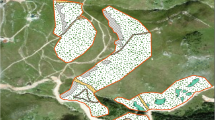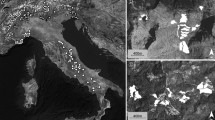Abstract
We investigate the use of landforms at different scales by males of the territorial nymphalid butterfly Inachis io (Linnaeus, 1758) under different weather conditions. They are known to use landforms at two different scales including macroscale, such as valley sides, tops of slopes and wood edges, and mini-landforms, such as molehills produced by the burrowing animal Talpa europaea Linnaeus (Linnaeus, 1758). Here, we demonstrate that they exploit microscale features on the molehills. The butterfly shifts its position in the landscape in relation to changing conditions by flying, and at the microscale, by walking. The links between thermoregulatory behavior and site selection indicate that perches are adopted to maintain body heat in the cool spring conditions when territories are established. Mini-landforms such as the molehills are adopted for their potential shelter and warmth in relation to ambient conditions; microsite selection typically includes warm niches on molehills, such as sunny slopes, sheltered margins and depressions. Shelter is adopted regardless of reduced visibility for territorial males. The importance of non-consumable (mate location) resources at different spatial scales is discussed in the context of habitat and the matrix.
Similar content being viewed by others
References
Baker, R. R. (1972). Territorial behaviour of the Nymphalid butterflies, Aglais urticae (L.) and Inachis io (L.). J. Anim. Ecol. 41: 453–469.
Dennis, R. L. H. (1970). Note on the relation of Aglais urticae L. to direct and shade temperatures. Ent. Rec. J. Var. 82: 302.
Dennis, R. L. H. (1983). Egg-laying cues in the wall brown butterfly, Lasiommata megera (L.) (Lep., Satryidae). Ent. Gaz. 34: 89–95.
Dennis, R. L. H. (1993). Butterflies and Climate Change, Manchester University Press, Manchester, UK.
Dennis, R. L. H. (2004a). Landform resources for territorial nettle-feeding Nymphalid butterflies: Biases at different spatial scales. Anim. Biodivers. Conserv. 27: 37–45.
Dennis, R. L. H. (2004b). Just how important are non-consumable resources as habitat components? Indications from a declining lycaenid butterfly with priority conservation status. J. Insect Conserv. 8: 37–45.
Dennis, R. L. H., and Shreeve, T. G. (1988). Hostplant-habitat structure and the evolution of butterfly mate-location behaviour. Zool. J. Linn. Soc. 94: 301–318.
Dennis, R. L. H., Shreeve, T. G., and van Dyck, H. (2003). Towards a functional resource-based concept for habitat: A butterfly biology viewpoint. Oikos 102: 417–426.
Dover, J. W., and Fry, G. L. A. (2001). Experimental simulation of some visual and physical components of a hedge and effects on butterfly behaviour in an agricultural landscape. Entomologia Exp. Appl. 100: 221–233.
Dover, J. W., Sparks, T. H., and Greatorex-Davies, J. N. (1997). The importance of shelter for butterflies in open landscapes. J. Insect Conserv. 1: 89–97.
Dover, J., Sparks, T., Clarke, S., Gobbett, K., and Glossop, S. (2000). Linear features and butterflies: The importance of green lanes. Agr. Ecosyst. Environ. 80: 227–242.
Ehrlich, P. R., and Hanski, I. (eds.) (2004). On the Wings of Checkerspots. A Model System for Population Biology, Oxford University Press, Oxford.
Greenacre, M. J. (1984). Theory and Applications of Correspondence Analysis, Academic Press: New York.
Hanski, I., Kuussaari, M., and Nieminen, M. (1994). Metapopulation structure and migration in the butterfly Melitaea cinxia. Ecology 75: 747–762.
Hardy, P. B., and Dennis, R. L. H. (2004). Seasonal and daily bias in butterfly perch height and substrate choice. Ent. Gaz. 55: 239–248.
Kemp, D. J., and Krockenberger, K. (2002). A novel method of behavioural thermoregulation in butterflies. J. Evol. Biol. 15: 922–929.
Kingsolver, J. G. (1985). Butterfly thermoregulation: Organismic mechanisms and population consequences. J. Res. Lep. 24: 1–20.
Krauss, J., Steffan-Dewenter, I., and Tscharntke, T. (2004). Landscape occupancy and local population size depends on host plant distribution in the butterfly Cupido minimus. Biol. Conserv. 120: 359–365.
Ludwig, J. A., and Reynolds, J. F. (1988). Statistical Ecology. A Primer on Methods and Computing, Wiley, New York.
Maier, C., and Shreeve, T. G. (1996). Endothermic heat production in three species of Nymphalidae. Nota Lepid. 18: 127–137.
Rutowski, R. L. (1991). The evolution of male mate-locating behavior in butterflies. Am. Nat. 138: 1121–1139.
Sears, F. W., and Zemansky, M. W. (1964). University Physics, Addison-Wesley, Reading, MA.
Shreeve, T. G. (1992). Adult behaviour. In Dennis, R. L. H. (ed.), The Ecology of Butterflies in Britain, Oxford University Press, Oxford, UK, pp. 22–45.
Shreeve, T. G., Dennis, R. L. H., and van Dyck, H. (2004). Resources, habitats and metapopulations—Whither reality?Oikos 106: 404–408.
Statsoft. (1999). STATISTICA for Windows 95/98/NT, Tulsa, OK.
Thomas, J. A. (1983). The ecology and conservation of Lysandra bellargus (Lepidoptera; Lycaenidae) in Britain. J. Appl. Ecol. 20: 59–83.
Wickman, P.-O. (1988). Dynamics of mate searching behaviour in a hilltopping butterfly Lasiommata megera (L.). The effects of weather and male density. Zool. J. Linn. Soc. 93: 357–377.
Author information
Authors and Affiliations
Corresponding author
Rights and permissions
About this article
Cite this article
Dennis, R.L.H., Sparks, T.H. Landscape Resources for the Territorial Nymphalid Butterfly Inachis io: Microsite Landform Selection and Behavioral Responses to Environmental Conditions. J Insect Behav 18, 725–742 (2005). https://doi.org/10.1007/s/0905-05-7022-7
Revised:
Accepted:
Issue Date:
DOI: https://doi.org/10.1007/s/0905-05-7022-7




